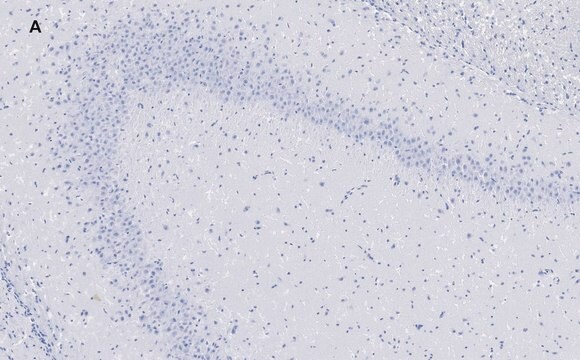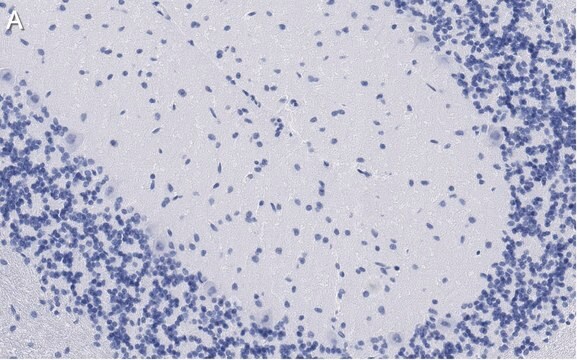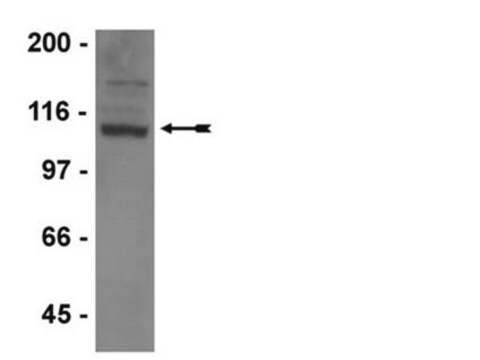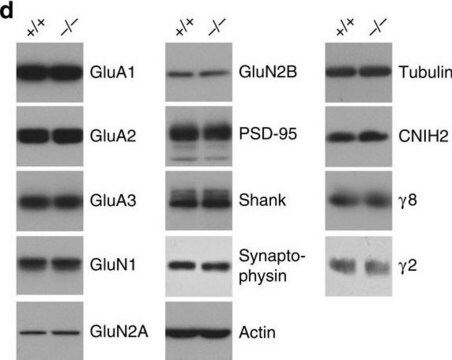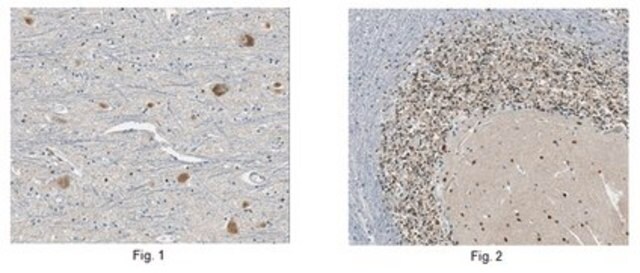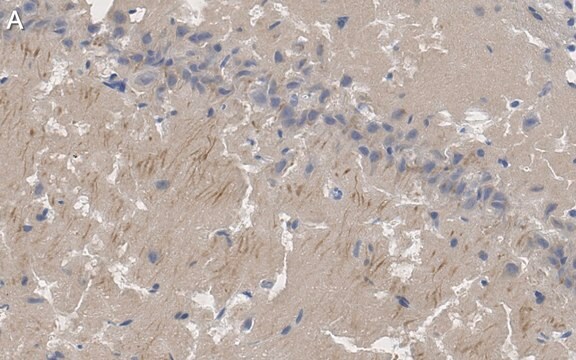おすすめの製品
由来生物
mouse
品質水準
抗体製品の状態
purified antibody
抗体製品タイプ
primary antibodies
クローン
14C12.2, monoclonal
化学種の反応性
mouse, rat, human
テクニック
immunohistochemistry: suitable (paraffin)
western blot: suitable
アイソタイプ
IgG2aκ
NCBIアクセッション番号
UniProtアクセッション番号
輸送温度
ambient
ターゲットの翻訳後修飾
unmodified
遺伝子情報
human ... GRIA2(2891)
詳細
Glutamate receptor 2 (UniProt P19491; also known as AMPA-selective glutamate receptor 2, GluA2, GluR-2, GluR-B, GluR-K2, GluR2, Glutamate receptor ionotropic, AMPA 2) is encoded by the Gria2 (also known as Glur2) gene (Gene ID 29627) in rat species. Glutamate receptors are synaptic receptors located primarily on the membranes of neuronal cells. These receptors play important roles in neural communication, memory formation, learning, and regulation by mediating glutamate-dependent postsynaptic excitation. Glutamate receptors are divided into two types, ionotropic glutamate receptors (iGluRs) and metabotropic glutamate receptors (mGluRs). iGluRs form ion channel pores upon glutamate binding, while mGluRs indirectly activate ion channels on the plasma membrane via G protein-coupled signaling cascade. Although all iGluRs and mGluRs bind glutamate, they do exhibit different binding activities toward chemical ligands, such as NMDA, kainate, AMPA, L-AP4, ACPD, L-QA, and such distinciton is used to divide these receptors further into subtypes. Glutamate receptor 2 is an AMPA type iGluR, GluR-1 is initially produced with an N-terminal signal peptide sequence (a.a. 1-24), the removal of which yields the mature receptor with 4 transmembrane helices (a.a. 544-564, 592-610, 617-637, 813-833), having a large N-terminal extracellular domain (a.a. 24-543), followed by two intracellular loops (a.a. 565-591, 611-616), one extracellular loop (a.a. 638-812) and a C-terminal cytoplasmic tail (a.a. 834-883).
特異性
Clone 14C12.2 targets an epitope within the N-terminal extracellular domain present in all spliced isoforms of human, mouse, and rat GluR2 reported by UniProt (P42262, P23819, P19491).
免疫原
GST-tagged recombinant rat GluR2 N-terminal extracellular domain fragment.
アプリケーション
Research Category
ニューロサイエンス
ニューロサイエンス
Anti-GluR2, clone 14C12.2, Cat. No. MABN1189, is a highly specific mouse monoclonal antibody, that targets Glutamate Receptor 2 and has been tested in Western Blotting and Immunohistochemistry (Paraffin).
Immunohistochemistry Analysis: A 1:50-1,000 dilution from a representative lot detected GluR2 in mouse (hippocampus) and human (cerebellum and cerebral cortex) brain tissue sections.
Western Blotting Analysis: 0.5 µg/mL of this antibody detected GluR2 in 10 µg of rat brain membrane extract.
Western Blotting Analysis: 0.5 µg/mL of this antibody detected GluR2 in 10 µg of rat brain membrane extract.
品質
Evaluated by Western Blotting in mouse brain membrane extract.
Western Blotting Analysis: 0.5 µg/mL of this antibody detected GluR2 in 10 µg of mouse brain membrane extract.
Western Blotting Analysis: 0.5 µg/mL of this antibody detected GluR2 in 10 µg of mouse brain membrane extract.
ターゲットの説明
~110 kDa observed. Target band size appears larger than the caluclated molecular weights (signal peptide removed) of 96.18/96.24/97.96/93.78 kDa (human isoform Flop/Flip/3/4), 96.02/83.54/101.9/100.2 kDa (mouse isoform 1/2/3/4), 90.05/96.11/97.78 kDa (rat isoform Flop/Flip/3) due to glycosylation. Uncharacterized bands may be observed in some lysate(s).
関連事項
Replaces: MAB397
物理的形状
Protein G purified.
Format: Purified
Purified mouse IgG2a in buffer containing 0.1 M Tris-Glycine (pH 7.4), 150 mM NaCl with 0.05% sodium azide.
保管および安定性
Stable for 1 year at 2-8°C from date of receipt.
その他情報
Concentration: Please refer to lot specific datasheet.
免責事項
Unless otherwise stated in our catalog or other company documentation accompanying the product(s), our products are intended for research use only and are not to be used for any other purpose, which includes but is not limited to, unauthorized commercial uses, in vitro diagnostic uses, ex vivo or in vivo therapeutic uses or any type of consumption or application to humans or animals.
適切な製品が見つかりませんか。
製品選択ツール.をお試しください
保管分類コード
12 - Non Combustible Liquids
WGK
WGK 1
引火点(°F)
Not applicable
引火点(℃)
Not applicable
適用法令
試験研究用途を考慮した関連法令を主に挙げております。化学物質以外については、一部の情報のみ提供しています。 製品を安全かつ合法的に使用することは、使用者の義務です。最新情報により修正される場合があります。WEBの反映には時間を要することがあるため、適宜SDSをご参照ください。
Jan Code
MABN1189:
試験成績書(COA)
製品のロット番号・バッチ番号を入力して、試験成績書(COA) を検索できます。ロット番号・バッチ番号は、製品ラベルに「Lot」または「Batch」に続いて記載されています。
John Lee et al.
eLife, 10 (2021-11-05)
Acoustic overexposure and aging can damage auditory synapses in the inner ear by a process known as synaptopathy. These insults may also damage hair bundles and the sensory transduction apparatus in auditory hair cells. However, a connection between sensory transduction
Lei-Lei Liu et al.
Molecular vision, 25, 780-790 (2019-12-11)
The neuromodulator dopamine plays an important role in light adaptation for the visual system. Light can stimulate dopamine release from dopaminergic amacrine cells (DACs) by activating three classes of photosensitive retinal cells: rods, cones, and melanopsin-expressing intrinsically photosensitive retinal ganglion
Shi Di et al.
eNeuro, 6(4) (2019-07-14)
Magnocellular neuroendocrine cells (MNCs) of the hypothalamus play a critical role in the regulation of fluid and electrolyte homeostasis. They undergo a dramatic structural and functional plasticity under sustained hyperosmotic conditions, including an increase in afferent glutamatergic synaptic innervation. We
Ann N Hoffman et al.
Neurotrauma reports, 2(1), 200-213 (2021-05-04)
Traumatic brain injury (TBI)-induced disruptions in synaptic function within brain regions and across networks in the limbic system may underlie a vulnerability for maladaptive plasticity and contribute to behavioral comorbidities. In this study we measured how synaptic proteins respond to
ライフサイエンス、有機合成、材料科学、クロマトグラフィー、分析など、あらゆる分野の研究に経験のあるメンバーがおります。.
製品に関するお問い合わせはこちら(テクニカルサービス)
